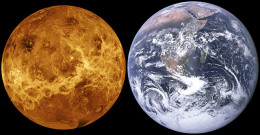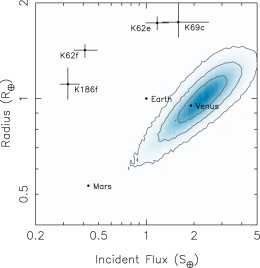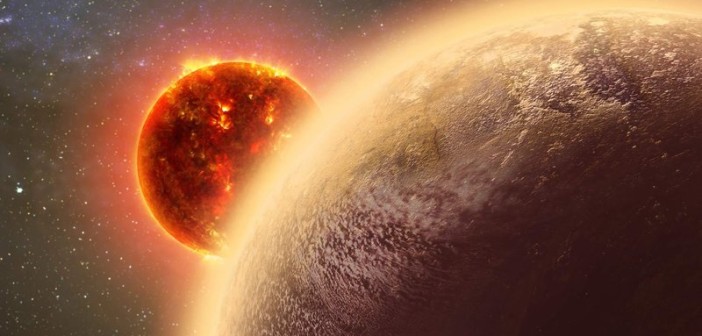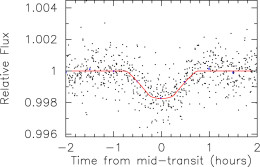
A size comparison of Venus and Earth. Though they are nearly the same size and density, these two planets evolved very differently. [NASA]
A New Neighbor
A team of scientists led by Isabel Angelo (SETI Institute, NASA Ames Research Center, and UC Berkeley) has announced the discovery of Kepler-1649b, an exoplanet transiting a star located just 219 light-years away from us. Kepler-1649b is unique in being roughly the same size as Earth and Venus and also receiving a similar amount of starlight as Venus does from our Sun.
Angelo and collaborators conducted follow-up observations after Kepler’s detection of 1649b to verify its planetary nature and pin down its properties. They found that Kepler-1649b has a radius of 1.08 times that of Earth, and it receives an incident flux of 2.3 times Earth’s — which is very similar to the incident flux received by Venus. Kepler-1649b orbits a star that’s only a quarter of our Sun’s radius, however, and it therefore orbits significantly closer to its star in order to receive the same flux, circling its host once every 8.7 days.Differences Due to a Small Host
It’s worth identifying how this planet might differ from Venus. The authors suggest a few key factors:
- Kepler-1649b may be more prone to effects of host-star variability. M-dwarf stars like this one are typically more magnetically active than our Sun, and Kepler-1649b is orbiting very close to its star.
- Kepler-1649b receives comparatively low-energy radiation, compared to Venus. This is because its cooler host emits more light at lower frequencies than the Sun.
- Kepler-1649b may be subject to larger tidal effects from its host star. Because it orbits so close in, it might experience tidal heating, synchronous rotation, and tidal locking — all of which can influence its seasons and geologic activity.
Target for the Future

The colored contours show the most likely radius and incident flux measured for Kepler-1649b. Earth, Venus, Mars, and several other exoplanets are plotted for comparison. [Angelo et al. 2017]
We will be able to gain more information on Kepler-1649b with upcoming missions. The Transiting Exoplanet Survey Satellite (TESS) will observe more transits, and Gaia’s improved-accuracy distance measurements should also improve our measurements of the star’s and planet’s properties. What’s more, Kepler-1649b will make an excellent target for the James Webb Space Telescope (launching in 2018) to examine in the hopes of learning about its atmosphere.
Citation
Isabel Angelo et al 2017 AJ 153 162. doi:10.3847/1538-3881/aa615f


7 Comments
Pingback: Un Eso-Venere nei Dintorni | Accademia delle Stelle
Pingback: Un exo-Venus en el vecindario local – Observatori Astronòmic
Pingback: Mayo 2017 – Observatori Astronòmic
Pingback: Exo-Venus « SEDA / LIADA - RedLIADA - Cursos LIADA - Cielo del Mes - Fenómenos Astronómicos - RELEA
Pingback: Un Exo-Venus | Sección de Exoplanetas - Planetas extrasolares / LIADA Liga Iberoamericana de Astronomía
Pingback: A new kind of animal in the exoplanet zoo | astrobites
Pingback: A New Kind of Animal in the Exoplanet Zoo